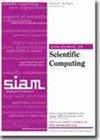利用汉密尔顿-雅可比多项式来解决某些科学机器学习问题
IF 2.6
2区 数学
Q1 MATHEMATICS, APPLIED
引用次数: 0
摘要
SIAM 科学计算期刊》,第 46 卷第 2 期,第 C216-C248 页,2024 年 4 月。 摘要。汉密尔顿-雅可比偏微分方程(HJ PDEs)与最优控制、微分博弈和成像科学等广泛领域有着深刻的联系。通过将时间变量视为高维量,HJ 偏微分方程可以扩展到多时域情况。在本文中,我们在机器学习中出现的特定优化问题与多时态霍普夫公式之间建立了一种新颖的理论联系,霍普夫公式对应于某些多时态 HJ PDEs 解的表示。通过这种联系,我们证明了当我们求解这些学习问题时,我们也求解了一个多时 HJ PDE,并进而求解了其相应的最优控制问题,从而提高了某些机器学习应用的训练过程的可解释性。作为对这种联系的初步探索,我们发展了正则化线性回归问题与线性二次调节器(LQR)之间的关系。然后,我们利用我们的理论联系来调整标准 LQR 求解器(即那些基于里卡提常微分方程的求解器),为机器学习设计新的训练方法。最后,我们提供了一些数值示例,展示了基于里卡提的方法在持续学习、训练后校准、迁移学习和稀疏动态识别方面的多功能性和可能的计算优势。本文章由计算机程序翻译,如有差异,请以英文原文为准。
Leveraging Multitime Hamilton–Jacobi PDEs for Certain Scientific Machine Learning Problems
SIAM Journal on Scientific Computing, Volume 46, Issue 2, Page C216-C248, April 2024.
Abstract. Hamilton–Jacobi partial differential equations (HJ PDEs) have deep connections with a wide range of fields, including optimal control, differential games, and imaging sciences. By considering the time variable to be a higher dimensional quantity, HJ PDEs can be extended to the multitime case. In this paper, we establish a novel theoretical connection between specific optimization problems arising in machine learning and the multitime Hopf formula, which corresponds to a representation of the solution to certain multitime HJ PDEs. Through this connection, we increase the interpretability of the training process of certain machine learning applications by showing that when we solve these learning problems, we also solve a multitime HJ PDE and, by extension, its corresponding optimal control problem. As a first exploration of this connection, we develop the relation between the regularized linear regression problem and the linear quadratic regulator (LQR). We then leverage our theoretical connection to adapt standard LQR solvers (namely, those based on the Riccati ordinary differential equations) to design new training approaches for machine learning. Finally, we provide some numerical examples that demonstrate the versatility and possible computational advantages of our Riccati-based approach in the context of continual learning, posttraining calibration, transfer learning, and sparse dynamics identification.
Abstract. Hamilton–Jacobi partial differential equations (HJ PDEs) have deep connections with a wide range of fields, including optimal control, differential games, and imaging sciences. By considering the time variable to be a higher dimensional quantity, HJ PDEs can be extended to the multitime case. In this paper, we establish a novel theoretical connection between specific optimization problems arising in machine learning and the multitime Hopf formula, which corresponds to a representation of the solution to certain multitime HJ PDEs. Through this connection, we increase the interpretability of the training process of certain machine learning applications by showing that when we solve these learning problems, we also solve a multitime HJ PDE and, by extension, its corresponding optimal control problem. As a first exploration of this connection, we develop the relation between the regularized linear regression problem and the linear quadratic regulator (LQR). We then leverage our theoretical connection to adapt standard LQR solvers (namely, those based on the Riccati ordinary differential equations) to design new training approaches for machine learning. Finally, we provide some numerical examples that demonstrate the versatility and possible computational advantages of our Riccati-based approach in the context of continual learning, posttraining calibration, transfer learning, and sparse dynamics identification.
求助全文
通过发布文献求助,成功后即可免费获取论文全文。
去求助
来源期刊
CiteScore
5.50
自引率
3.20%
发文量
209
审稿时长
1 months
期刊介绍:
The purpose of SIAM Journal on Scientific Computing (SISC) is to advance computational methods for solving scientific and engineering problems.
SISC papers are classified into three categories:
1. Methods and Algorithms for Scientific Computing: Papers in this category may include theoretical analysis, provided that the relevance to applications in science and engineering is demonstrated. They should contain meaningful computational results and theoretical results or strong heuristics supporting the performance of new algorithms.
2. Computational Methods in Science and Engineering: Papers in this section will typically describe novel methodologies for solving a specific problem in computational science or engineering. They should contain enough information about the application to orient other computational scientists but should omit details of interest mainly to the applications specialist.
3. Software and High-Performance Computing: Papers in this category should concern the novel design and development of computational methods and high-quality software, parallel algorithms, high-performance computing issues, new architectures, data analysis, or visualization. The primary focus should be on computational methods that have potentially large impact for an important class of scientific or engineering problems.

 求助内容:
求助内容: 应助结果提醒方式:
应助结果提醒方式:


